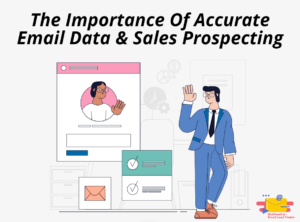
Having a high-quality email list is a half-battle won. However, a poorly maintained one with invalid or outdated email addresses can lead to a catastrophe! It means higher bounce rates, spam complaints and damage to your sender reputation. This is where email list validation comes into play!
Email list validation is the process of verifying the accuracy and validity of the email addresses in your list. Ensure that your emails are delivered to valid, active inboxes, hence reducing bounce rates and avoid the risk of being marked as spam.
We’ll explore the critical role of email list validation, how it works, and why it’s essential for maintaining a healthy and effective email marketing strategy.
What is Email List Validation?
Email list validation involves checking each email address in your database to ensure it is valid, active, and able to receive emails. This process helps identify and remove addresses that could cause issues like bounces, spam complaints, or deliverability problems.
The validation process typically involves multiple checks, including syntax validation, domain validation, and mailbox verification. These checks ensure that the email addresses are correctly formatted, belong to a legitimate domain, and are associated with active mailboxes.
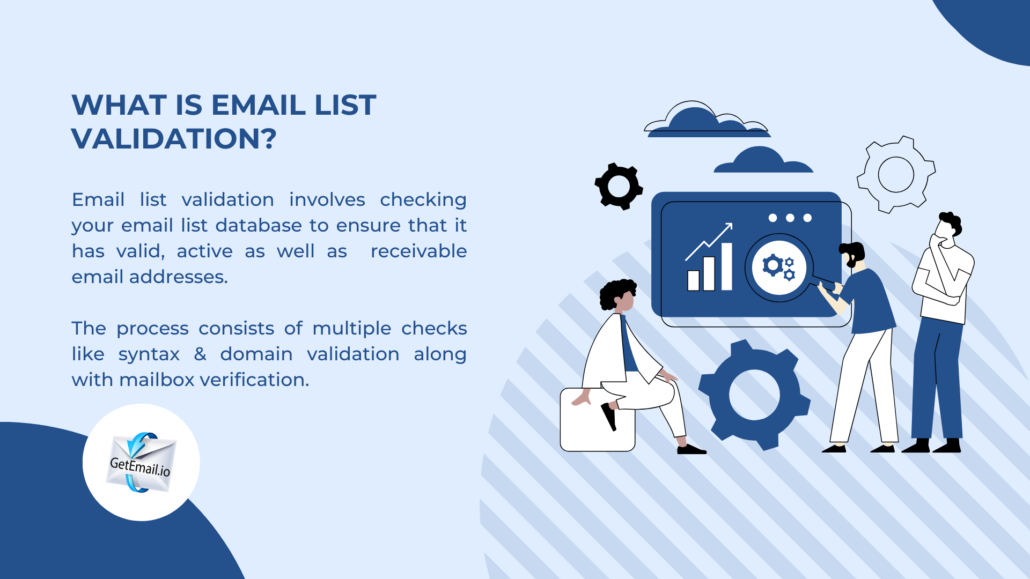
When it comes to validation, GetEmail.io has high results. It doesn’t just search for the email addresses you’re looking for but also validates its authenticity.
It comes with chrome extension where you can not only check email on social media platforms like LinkedIn but also on Gmail, Salesforce, etc.
The Importance of Email List Validation
Validating your email list should be one of the significant workflow standards to ensure that overall branding is not tarnished. Especially in email marketing where every email counts, you need to consider these aspects below for a smoother campaign.
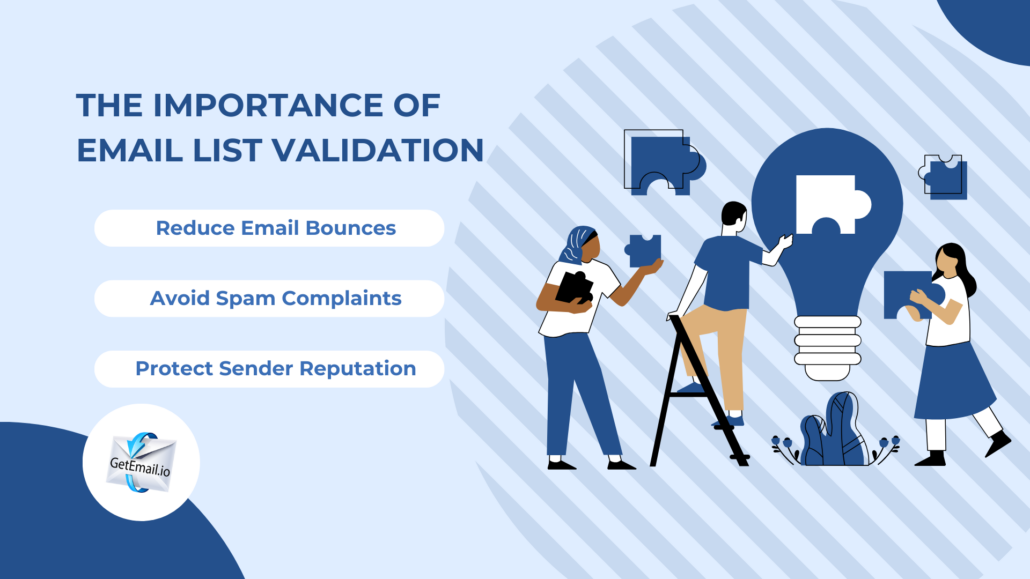
- Reducing Email Bounces
When a certain percentage of emails are returned to the sender because they couldn’t be delivered to the recipient’s inbox, it is counted as a bounced email. The more bounces an email gets, the higher the bounce rate goes.
This can severely impact the overall email marketing efforts and harm your brand’s reputation. There are two types of bounces:
- Hard Bounces: These occur when an email cannot be delivered due to a permanent issue, such as an invalid email address or a non-existent domain. Hard bounces are particularly problematic because they indicate that the email address is entirely unusable.
- Soft Bounces: These are temporary delivery failures caused by issues such as a full inbox or a server error. While soft bounces are less damaging than hard bounces, they can still affect your campaign performance if they occur frequently.
Email validation can of course be one of the solutions to reduce both hard and soft bounces. Validation tools help you identify invalid email addresses before you send your campaign, ensuring that your emails are only sent to active recipients.
Here’s a quick sneak into the latest delivery data (2023) by GDMA. This is the global average of email deliverability.
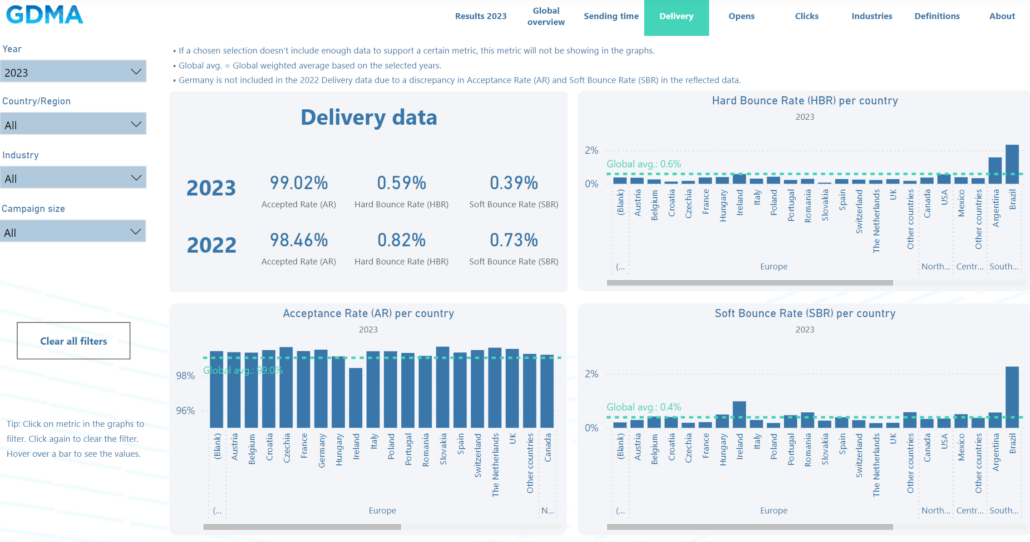
- Avoiding Spam Complaints
Another hurdle a marketing faces when it comes to email marketing is spam complaints. When recipients mark your email as spam, it signals to email service providers (ESPs) that your content is unwanted or irrelevant.
A high number of spam complaints can lead to your emails being automatically filtered into the spam folder or, worse, your domain being blacklisted.
Make sure that the emails are sent to interested recipients only; that takes the edge off the risk of spam complaints. Double-check your email list by removing inactive and unengaged subscribers that reduces the likelihood of your emails being marked as spam.
- Protecting Your Sender Reputation
Your sender reputation is a score assigned to your email domain by ESPs, based on factors like bounce rates, spam complaints, and engagement levels. A good sender reputation is essential for maintaining high email deliverability, ensuring that your emails reach your recipients’ inboxes.
A poor sender reputation can lead to your emails being blocked or sent to the spam folder, drastically reducing the effectiveness of your campaigns. Schedule regular check-ins with your email list to maintain a healthy sender reputation and maximize your email deliverability.
The Actual Science Behind Email List Validation
Every email goes through series of check before being validated as a genuine one. Here’s a breakdown of the typical validation process:
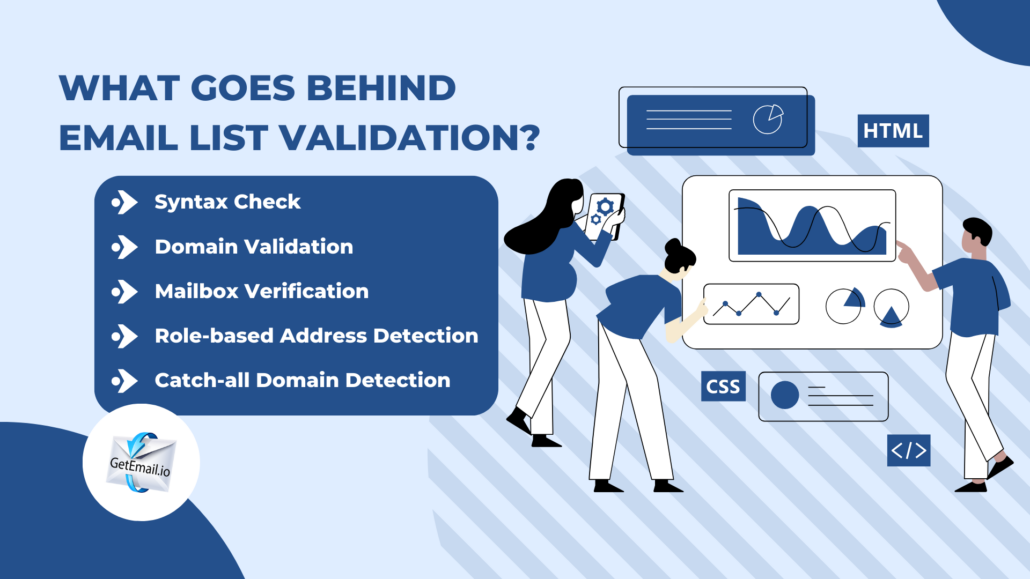
1. Syntax Check
The first step in email validation is checking the syntax of each email address. This involves verifying that the email address is correctly formatted according to the standard email syntax rules. For example, a valid email address should have the format username@domain.com, with no spaces or special characters in the wrong places.
Syntax errors can include:
- Missing the “@” symbol.
- Incorrect domain format.
- Use of invalid characters.
While syntax errors are relatively rare, they can still occur, especially if email addresses are manually entered into your database. The syntax check helps catch these errors before they cause bounces.
2. Domain Validation
After checking the syntax, the next thing is to validate the domain of each email address. This usually involves verifying that the domain (e.g., gmail.com, yahoo.com) is valid, active, and able to receive emails.
Domain validation ensures that the email address is associated with a legitimate domain that has a functioning mail server.
Invalid domains can occur if the domain name has been misspelled, is outdated, or if the domain no longer exists. Sending emails to invalid domains result in hard bounces, so you’ve got to catch these issues way before the email campaigns begin.
3. Mailbox Verification
The final step, yet the most important one, is mailbox verification. It involves checking whether the specific email address is associated with an active mailbox that can receive emails.
This step is critical because even if an email address has the correct syntax and is associated with a valid domain, it may still not be valid if the mailbox has been deactivated or doesn’t exist.
Mailbox verification typically involves a process known as “pinging” the email server to check if it accepts mail for the specific address. If the server responds positively, the address is considered valid. If not, it’s flagged as invalid and should be removed from your list.
4. Role-Based Address Detection
Role-based email addresses like, info@domain.com, sales@domain.com, etc. are often associated with departments or groups rather than individual recipients. These addresses are more likely to result in low engagement rates (or even spam complaints) because they are typically monitored by multiple people or used for specific purposes.
During the validation process, role-based addresses are identified and flagged. Depending on your marketing strategy, you may choose to remove these addresses from your list to reduce the risk of spam complaints.
5. Catch-All Domain Detection
Some domains are configured as “catch-all” domains, meaning they accept emails sent to any address within the domain, even if the specific mailbox doesn’t exist. While this might seem beneficial, catch-all domains can lead to higher bounce rates if the mailbox doesn’t actually exist or isn’t monitored.
Validation tools detect catch-all domains and flag them for further review. Depending on your preferences, you may choose to keep or remove these addresses from your list.
Benefits of Email List Validation
You can only benefit from the quality check done through email list validation, and not any other way around. Here’s the list why you need to consider incorporating email validation tool in your workflow,
- Improved Deliverability
As mentioned earlier, a validated email list helps improve your overall deliverability. Protect your sender reputation by ensuring the email are sent to valid as well as active recipients. The likelihood of your message being bounced greatly reduces.
- Higher Engagement Rates
Sending emails to a validated list of active and interested recipients leads to higher engagement rates. When your emails reach the right inboxes, you’re more likely to see better open rates, click-through rates, and conversions. This also translates into a higher return on investment (ROI) for your email marketing campaigns.
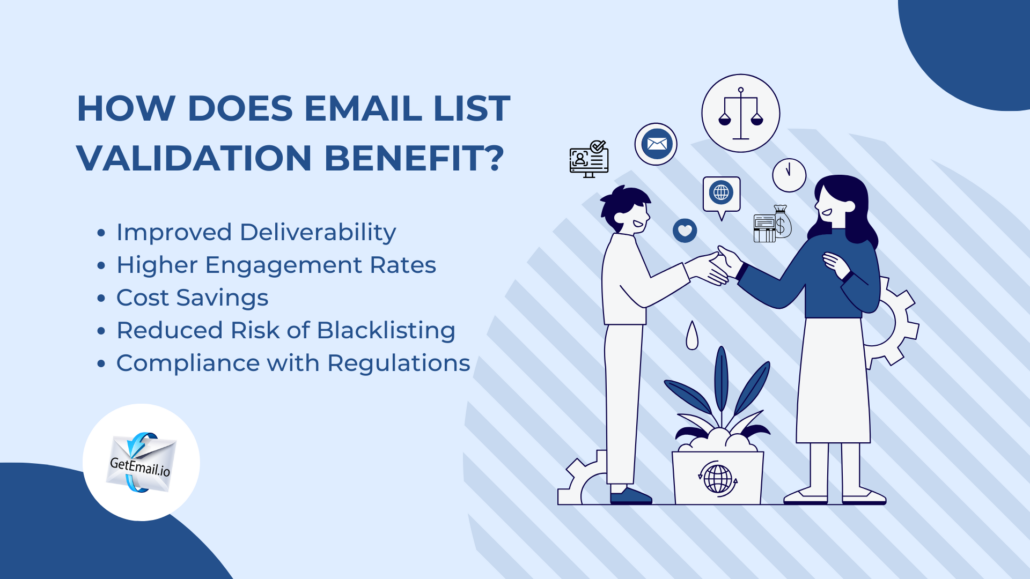
- Cost Savings
Many email marketing platforms charge based on the size of your email list. By removing invalid or inactive email addresses, you can reduce your list size and lower your costs. Moreover, improving your deliverability/engagement rates would maximize the effectiveness of your campaigns, leading to better results with less spend.
- Reduced Risk of Blacklisting
Being blacklisted by email service providers can be devastating for your email marketing efforts. Once blacklisted, your emails may be blocked entirely, preventing them from reaching your audience. Email list validation helps prevent this by reducing bounce rates, spam complaints, and other factors that could harm your sender reputation.
- Compliance with Regulations
Data protection regulations, such as GDPR and CAN-SPAM, require businesses to maintain accurate as well as up-to-date email lists. Regular validation ensures that your list complies with these regulations, reducing the risk of legal issues and fines.
Best Practices for Email List Validation
Get the most out of email list validation by following best practices. Here are some tips to help you maintain a healthy email list:
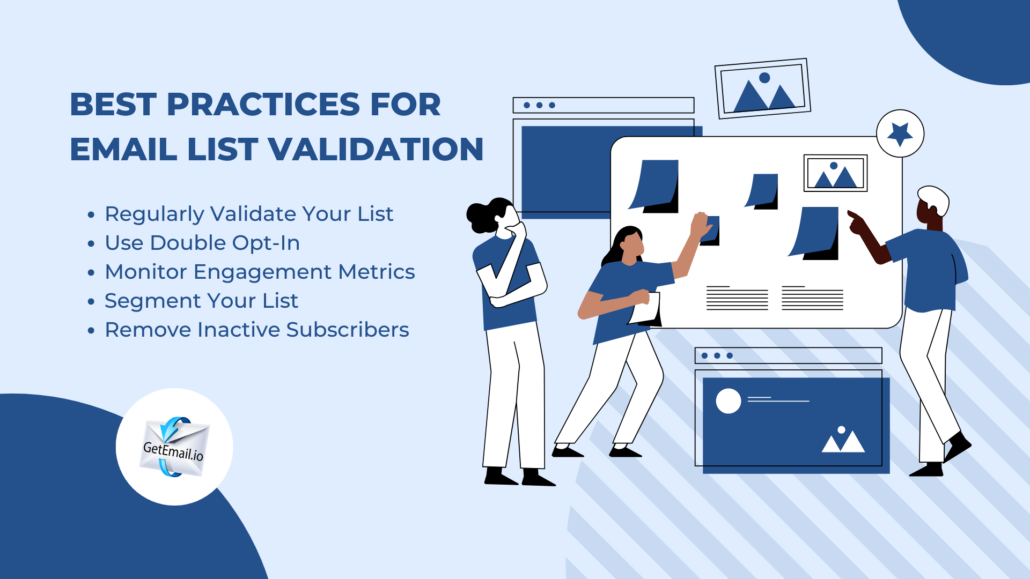
1. Validate Your List Regularly
Email lists naturally degrade over time as people change jobs, switch email providers, or abandon old accounts. Keep your list fresh and accurate by essentially validating it regularly. Depending on the size and frequency of your campaigns, this could be every few months or before each major campaign.
2. Use Double Opt-In
Implementing a double opt-in process ensures that only valid and engaged email addresses are added to your list. With double opt-in, new subscribers must confirm their email address by clicking a link in a confirmation email. This helps prevent fake or mistyped email addresses from being added to your list.
3. Monitor Engagement Metrics
Keep an eye on your engagement metrics, such as open rates, click-through rates, and bounce rates. If you notice a decline in these metrics, it may be time to validate your list. Regularly monitoring these metrics can help you identify potential issues early on and take corrective action.
4. Segment Your List
Segmenting your email list allows you to tailor your messages to specific groups of recipients, improving engagement and reducing the risk of spam complaints. During the validation process, you can also segment your list based on engagement levels, removing or re-engaging inactive subscribers.
5. Clean Your List of Inactive Subscribers
Periodically remove inactive subscribers from your list to improve your overall deliverability and engagement rates. While it can be tempting to keep a large list, inactive subscribers can drag down your metrics and increase the risk of being marked as spam. Consider sending a re-engagement campaign to inactive subscribers before removing them from your list.
Let’s Recap Everything About Email List Validation
Email list validation is not just a recommended practice; it’s an essential component of a successful email marketing strategy. You need to ensure that the email list is clean and accurate to avoid any bounce rates or spam complaints.
The upside to having valid email addresses is that you get better deliverability, higher engagement rates and more effective marketing campaigns!
We now live in world where every person has an average of at least 2.5 email addresses! So, finding the one and making sure it is correct is your duty to make your marketing campaign a success.
Keep your list fresh with targeted audience, ensure that the content is engaging and keeps the reader wanting for more.
Investing in email list validation is not just about compliance or avoiding penalties—it’s about optimizing your marketing efforts for long-term success.
If building a strong relationship with the target audience and maximizing ROI is your marketing goal, then it should start from building a high-quality email list. And, what’s better than trying out GetEmail.io that comes with amazing integrations and APIs for you to smoothen your workflow!





